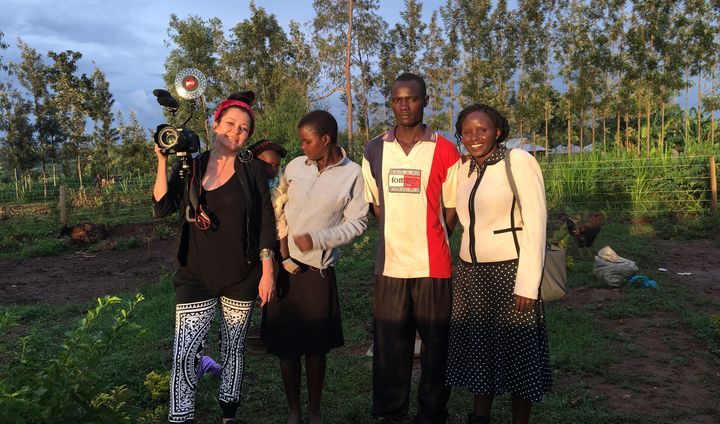
”Heroines of Health” filmmaker, Lisa Russell, with Mercy and a family featured in the film. Lwala, Kenya.
A few years ago, I was asked to preview a documentary film that followed several women in South Africa who were HIV positive seeking anti-retroviral treatment. As a filmmaker who primarily produces and curates global health films for UN/NGO agencies, this was something I was accustomed to and enjoyed doing. The documentary had an $800,000 budget (which is incredible!) and the development agencies and filmmakers spent two years (also incredible!) producing it, so I was very excited to see it.
As the film began, minute by minute I felt less optimistic about the potential of the film. Although it was beautifully shot, it fell quickly into the trap of old school development storytelling. It started with text slates that basically told the entire story up front. It had one dimensional characters. It victimized women. It was a flat story.
Even though there are many well produced stories around global health and women, many of them fall flat. They perpetuate harmful narratives and often do not give us a holistic view of the women whose stories are being told They often focus on women as only victims of poor health. They can strip women of their dignity and can actually promote hopelessness when women constantly see themselves as problems and failures instead of as solutions with a wealth of possibilities.
So when GE Healthcare contacted me about an idea they had to invest in a documentary film profiling women leaders in global health - and they were open to my shooting it as a character driven film - I was ecstatic. They provided the funding, logistical support and identified the three women - Dr. Sharmila (India), Mercy (Kenya) and Mrs. Rohani (Indonesia) - while giving me creative freedom to tell their stories in the most innovative and authentic way possible.
Since this was a film about three women from different parts of the world who didn’t know each other and I wouldn’t be filmming them together, I had to figure out what story structure I would use to ensure their stories are told in the best way possible. I decided to tell their stories in segments similar to a film I previously directed called, “We Will Not Die Like Dogs” that profiled four African AIDS activists from Burkina Faso, Nigeria, Uganda and Zambia. Creating a film that is told in segments in actually pretty tricky because you risk duplicating narratives to a point where the audience can predict what happens next and that’s a sure fire way to make a viewer lose interest in your film.
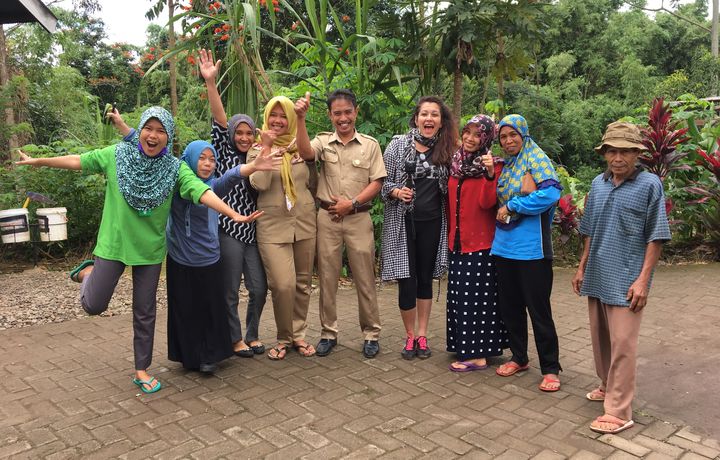
Filmmaker, Lisa Russell and Mrs. Rohani, featured in the film, departing from the local police department to obtain clearance before filmming.
With ”Heroines of Health”, I chose to break down each woman’s story into four segments. First, we would learn about them as individual women - their backgrounds, their hopes, and their fears. Then, we would learn about he incredible work they do - all driven by passion and purpose. Then we would get a glimpse into the struggle or conflict they each experienced as women in global health. Then we would resolve their stories by learning what keeps them going. This dictated how I planned to shoot their stories. I didn’t have a lot of time in each location so I had to be very efficient in terms of what I chose to film.
Another thing I had to come to terms with is what I wasn’t going to film. A common phenomenon I experience while shooting these types of films is that I’m given too much material to work with. Some clients set up what I call “donor visits” for me and escort me to numerous sites to meet and potentially interview all the experts, practitioners, patients and others that local organizations usually are accustomed to organizing when doing site visits. With this format, however, I’m stretched too thin and never allowed to go too deeply into a story and that often leads to a film being more issue based than character driven. So, while scheduling my shoot in India for example, I was suppose to visit two sites - one that was 8 hours away by car and one that was 1.5 hours away. Since I would be seeing basically the same thing in both sites, I requested we only visit one site and film there all day. That left me more time to shoot Dr. Sharmila with her daughter including an intimate and emotional two hour dinner that gave me the opportunity to get in depth look into their really touching story.
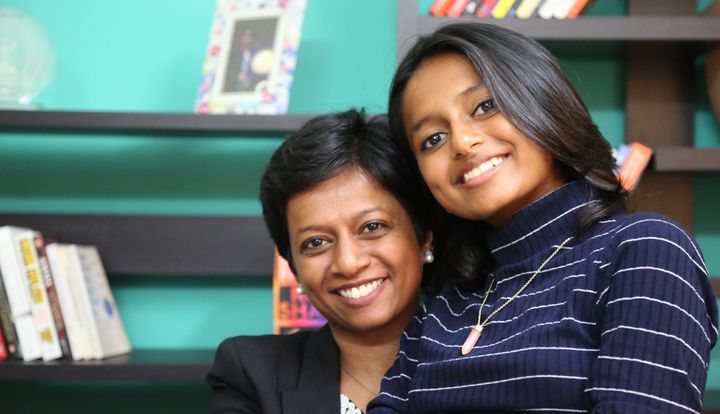
Dr. Sharmila, featured in the film, with her daughter Ashlie at her office at SEHPL. Chennai, India.
When preparing to interview and shoot Dr. Sharmila, Mercy and Mrs. Rohani, I wanted to introduce them first as women, before introducing them as women working on global health issues. So the plan was to shoot a “day in the life of” each character. With Dr. Sharmila, I arrived at her home in Chennai, India at 5:30am at sunrise, to film her doing her normal morning routine - doing yoga, catching up on emails, getting ready to head into her office. She talks about expectations of her as a child and as a mother as well as the hardships she endured leaving her then 3 year old daughter behind to pursue an education in the U.S. Mercy is seen in the small community of Lwala, Kenya where she talks about her dream to work with women and then she talks about her family - how she and her husband made a decision to live separately so her children could have the best education possible. Mrs. Rohani from Indonesia is seen walking up a steep mountain, over bamboo bridges to a rural village where she started living after she got married and explains how she only finished junior high school but became a volunteer midwife assistant.
The next segment was to focus more directly on each woman’s work. Dr. Sharmila runs a social enterprise called SEHPL and does a lot of administrative work. This doesn’t always translate into interesting material so my goal was to see her out in the field speaking with the girls in her program and meeting the families who, for numerous reasons, could not let their daughters attend the training program. Mercy escorted us through the Lwala Community Alliance Hospital’s children’s ward where we came upon many compelling stories of families with sick children. And finally Mrs. Rohani, while selling goods and picking up items at her local market, identifies pregnant women and escorts them to the health clinic.

Mrs. Rohani, featured in the film, giving a young pregnant women prenatal vitamins as recommended by the local health clinic’s midwife. South Sulawesi, Indonesia.
What was revealing to me in shooting this particular segment was how often each woman wanted to ensure members of her team had a chance to speak or be on camera. In a few places, I could sense the male healthcare workers felt a bit out of place because they were accustomed to being the ones who spoke or who led the conversation. In order to work diplomatically, I gave them opportunity to speak in front of the camera, knowing full well that I was focused on the heroines of the film. Women stepping aside to give others a voice illustrates to me that women have an inherent commitment to social inclusion, ensuring everyone on their team was recognized.
Shooting the third segment - the climax or conflict of each story - is usually the most challenging part of making a film. I was in each location for a matter of days and with documentary film, you never know what you will see. How do I identify the climax of a woman’s journey if nothing really happens? So my goal was to document each woman on the front lines of what they do with the hopes something dramatic would happen. We see Mercy in a children’s ward in a hospital. We see Mrs. Rohani in a maternal health clinic. And we see Dr. Sharmila in a small hut, convincing a father to allow his daughter to attend her program. For all three heroines, we get to see them break out of interview mode and slide into their natural habitat where they take charge, lead, and solve life threatening problems - situations they are exposed to even when the camera is not rolling.
The women themselves are all unique and represent a diverse representation of women in global health - from the highly educated living and working in an urban area, to the volunteer living with few resources in a really remote area. In order to best differentiate their stories, I also decided to focus their stories on different global health themes. Dr. Sharmila worked on promoting girls education and employment, Mercy worked on decreasing under five child mortality and Mrs. Rohani worked to promote improved maternal health. Every shot in every scene was intended to support their theme without again it becoming too “issue based.” I could have introduced a bunch of statistics, explored the issue in depth, or covered a wealth of other global health issues as each woman works with communities dealing with many health obstacles but it would dilute the story and make it too hard to digest. As we say in documentary filmmaking, “less is more.”

Filmmaker Lisa Russell speaking on Narrative Justice at the Global Health Corps Training Institute at Yale University. New Haven, CT.
My approach to documentary filmmaking has always been to change the narrative of global health stories and “narrative justice” is the platform which I speak about it. I never went to film school but I became interested in filmmaking after getting my Masters in Public Health in International Health and working as a humanitarian aid worker in Kosovo and Albania during the 1999 refugee crisis. Sitting in a high level meeting at the US Embassy in Albania, I listened as two Kosovar women who were living in the refugee camps talked about being upset with the journalists covering the war. They said they were fixated on telling the story of rape being used as a tool of war (an important story) and were asking women who had been raped to raise their hands.
What they said after that was really the driving force for my wanting to tell development stories differently.
They said, “Not only are the journalists disrespecting what we are going through, but we fear that at the end of this war, we will no longer be remembered as Kosovar women but as Kosovar women who’ve been raped.”
That led me down a path of critiquing news reports, and PSAs and documentary films about how women were portrayed in the media. Often they were victims of abuse, sexual assault, and were portrayed as powerless. I did a series of films on obstetric fistula and other maternal health issues, as well as HIV/AIDS and the impact of war on youth. I was always challenging myself and my UN/NGO colleagues to explore alternative ways of telling these stories without victimizing the women in them. My goal was to change the narrative of stories that focus on charity to evoke pity, to one of justice to promote empowerment.
As a woman who directs, produces, shoots and edits global health stories, I also have had my share of obstacles working in two industries that are often male dominated - filmmaking and global development. I have overcome many obstacles and made enormous sacrifices to do what I do which allowed me to bond with each woman in the film. I, too, had to fight against expectations of what others wanted for my life with my brother, for example, pointing out that at 30 years old I wasn’t married and didn’t have a car or house so he asked, “what are you doing with your life?” Like many women in global health, I had to ignore all outside noise and focus on what I believed was my purpose: to bring my creativity, intelligence and passion for doing good in the world all together in one career as an artist and filmmaker.
Although we work at different points of the global health spectrum, I believe we all struggled with familial and cultural expectations of how a woman should balance career with family, struggling to get paid and recognized appropriately for our work, and fighting against the systemic obstacles placed before us. As Dr. Sharmila has said, “I’m a rebel. So, sorry.” I think that phrase could have come from the other two women as well as myself.
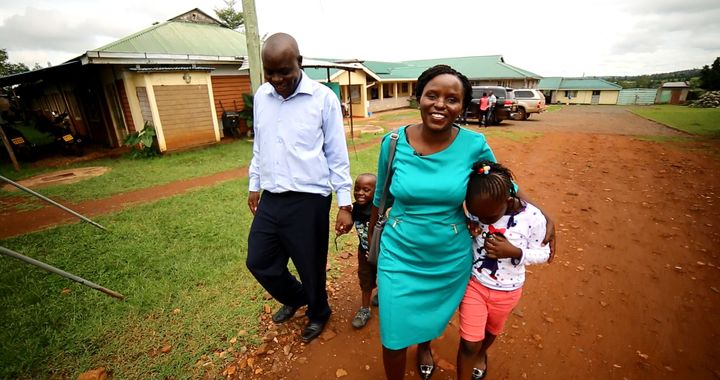
Mercy, featured in the film, with her husband and two children. Lwala, Kenya.
As women in global health, I believe we have a responsibility to emerging global health advocates and practitioners to tell our own stories, to inspire others through seeking platforms to share our journey, to mentor young women and to advocate against systemic barriers that keep us from reaching our fullest potential. I’m personally on a mission to inspire and train a new wave of responsible storytellers in global health. With “Heroines of Health”, I had the great honor of telling the story of three remarkable women although there are so many more stories to be told. As I do screenings and workshops with “Heroines of Health”. my goal is to get global health experts to think critically about stories we tell about women - not just as expert storytellers but global health workers in general. And for us to change the narrative of how we see and support women in the field.
Because if we truly believe that women and girls are powerful, we need to stop telling stories that they’re not.
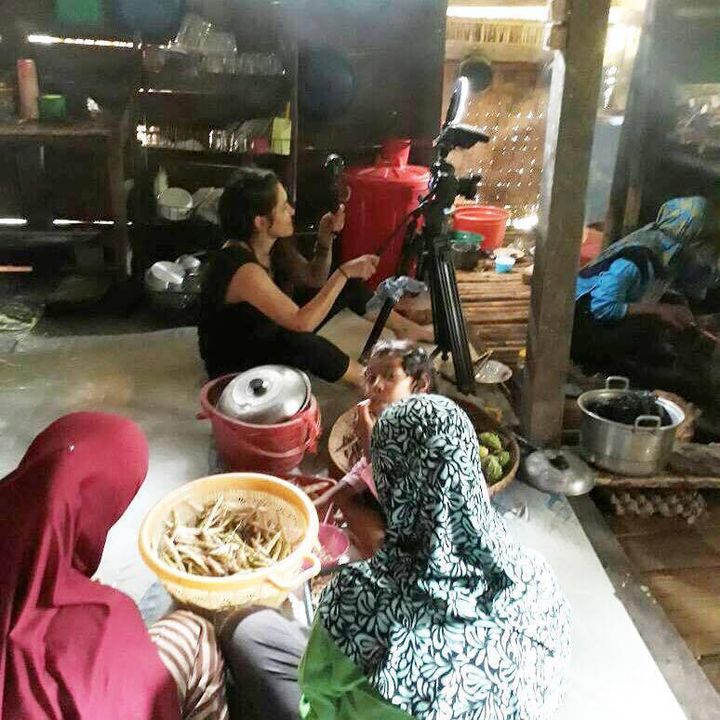
Filmmaker, Lisa Russell, filmming Mrs. Rohani as she prepares dinner with her daughters and nieces. South Sulawesi, Indonesia.
Lisa Russell, MPH is an Emmy-award winning filmmaker and global health advocate with 10+ years producing films and creative campaigns for UN/NGO agencies. For more information and/or to book a “Heroines of Health” screening or workshop, visit her website at www.lisarussellfilms.com.
”Heroines of Health” is a film by Lisa Russell, MPH, executive and co-produced by GE Healthcare.
You can watch the film in its entirety below. Share with your social media contacts using #HeroinesofHealth.
